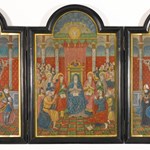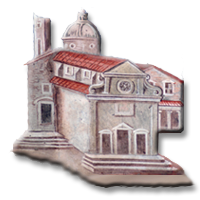Introduzione
fonte: www.sothebys.com
central panel and two wings, 440mm. by 285mm. (rectangular central panel with semi-circular extension at top) and 440mm. by 120mm. (each wing), gouache and gold on vellum, the central panel by the artist Etienne Colaud with the Virgin Mary enthroned, flanked by Mary Magdalene and three other female saints with open books in their laps, accompanied by the Apostles and other men on both sides, with the Dove of the Holy Spirit and tongues of flames descending from heaven, the wings by the Master of François de Rohan; left wing showing Charlemagne, Holy Roman Emperor (747-814), dressed in armour and a cloak decorated on one side with the German imperial eagle and on the other with the French fleur-de-lys, wearing the imperial crown and holding a globe and a sword, the right wing showing St. Augustine of Hippo (354-430), wearing a mitre and holding a crozier and a small enthroned trinity (probably alluding to his theological work, De Trinitate), both wings with angels holding scrolls inscribed with parts of a prayer to the Holy Spirit: left wing, “Veni sancte spiritus reple tuorum corda fidelium et tui amoris in eis ignem accende”; right wing, “O [lux] deatissima [sic, for beatissima] reple cordis intima tuorum fidelium”, the central panel with scratches in the sky and on the right-hand side, the wings perhaps at some stage water-damaged at top and their tops replaced in the nineteenth century, some small areas of the legs of Charlemagne, the angels’ wings and the sleeve of St. Augustine retouched at the same time, the inscriptions partly (in places erroneously) rewritten, else in outstandingly fresh and clean condition, perhaps originally pinned to boards and then pasted to present boards when framed in the nineteenth century, edges of all vellum sheets regilded in nineteenth century, small remnants of printed papers (perhaps in French) and canvas on back from covers once pasted there, nineteenth-century wooden frame cracked in places
Provenance
This vast devotional miniature, executed by two of the finest manuscript illuminators of the French court, is a hitherto unrecorded Renaissance masterpiece. It is perhaps the grandest extant French example of the rarest and most fragile form of the manuscript illuminators’ art – miniature painting on free standing vellum panels
This was a grand commission for a patron of royal or near-royal status, executed in Paris in the second quarter of the sixteenth century. It is larger than the Bourdichon painting on vellum sold by Christie’s, 6 July 2004, lot 98 (which was 396mm. high, and perhaps once the central section of a triptych like the present example), and is almost on a par with Bening’s greatest surviving work in this media. Both artists here are documented working for the French court in the period in which this was made. While the presence of St. Augustine on one wing probably relates to his discussions of the Trinity, the presence of Charlemagne, dressed in a cloak partly of fleur-de-lys, is unrelated to the other imagery here, and suggests that the original commissioner was a member of the court of François Ier (1494-1547; king of France and father of the French Renaissance, patron of Leonardo da Vinci, owner of the Mona Lisa, and perhaps the greatest bibliophile of the sixteenth century), or perhaps the monarch himself.
Catalogue note
The production of paintings by manuscript illuminators on free standing vellum leaves was an opulent but short-lived genre at the very end of the Middle Ages. It saw its heights in the French and Burgundian Netherlandish courts in the second quarter of the sixteenth century (see Kren in Illuminating the Renaissance, 2003, pp.480-1). It stood quite apart from panel painting, and its productions were intended to be kept loose (as in the case of René of Anjou’s parchment roll with a portrait of his wife, the queen of Sicily: listed in his 1471/2 inventory of possessions in the château at Angers) or pinned to a wooden frame (as depicted in the panel-painting of a young man by Petrus Christus, c.1450, now London, National Gallery, NG2593, in which the corner of the picture on the wall behind the subject lifts and curls, revealing it is on vellum not board; see Illuminating the Renaissance, 2003, p.25 for a reproduction). The production of these artworks was most probably driven on by shifts in late medieval devotional practises, as well as the development of increasingly large and monumental books for the French and Burgundian aristocracy, with vast miniatures each the size of a panel-painting. The same artists who painted lavish devotional books and secular romances, appear to occasionally have taken on these commissions, but of course the results were far more fragile and susceptible to the elements than paintings within books, and only a tiny handful now survive. In Flanders their production is synonymous with the artist Simon Bening, and his finest is the Penitent St. Jerome, c.1530, 640mm. high, now in the Escorial, Monasterio de San Lorenzo (see Illuminating the Renaissance, 2003, fig.15 for a reproduction).
Surviving French examples are far rarer. In 1380, Charles V appears to have owned an illuminated vellum triptych of the Crucifixion flanked by saints, but it is lost. As noted above, a single panel illuminated by the celebrated Tours artist Jean Bourdichon, was sold in Christie’s in 2004. Bourdichon is known to have executed other commissions of this form including a view of Caudebec painted on five skins glued together, and twenty-four paintings each on half a skin with scenes of boats and sailors, for which Louis XI paid him 8 livres tournais in 1480 (MacGibbon, Jean Bourdichon, 1933, p.137). The present triptych is the only evidence that Etienne Colaud and the Master of François de Rohan also worked in this media.
the artists
The central panel with the Pentecost is the work of Etienne Colaud (Paris, fl. c.1512/13, d. 1541/42) who is attested in two documents dating from 1523 and 1528 for the illumination on each occasion of six copies of Statues of the Order of St. Michael for François Ier. This artist has been identified only recently, his name being mentioned in the colophon of a Book of Hours dated 1512/13, now in a private collection (M.-B. Cousseau, ‘Étienne Colaud, enlumineur et libraire parisien: à propos d’un livre d’heures portant sa souscription’, Bulletin du bibliophile, 2010, pp.11-35). Characteristic for Colaud are serene figures, lightly modelled hair and the majestic Renaissance architecture with colourful tiles.
The other artist who painted the wings with Charlemagne and St. Augustine is the Master of François de Rohan, who was active between c.1525-46 (M. Orth, ‘The Master of François de Rohan: a Familiar French Renaissance Miniaturist with a New Name’, in Illuminating the Book: Makers and Interpreters, 1998, pp.69-91). He was first named the Master of François Ier after a sumptuously illuminated Book of Hours executed in 1539/40 for, or for presentation to, that monarch (first identified by Backhouse in British Museum Quarterly 31, 1966-67, and sold in Arcana part I at Christie’s, 7 July 2010, lot 47; note also its sister volume produced by the same artist for Anne de Montmorency, François Ier’s childhood friend, in our rooms, 6 July 2010, lot 35, later J. Günther, Brochure 12, Faith and Knowledge, no.24), and was renamed by François Avril after a Fleur de Vertu dated 1530 (Paris, BnF., fr.1877) whose translator, François de Rohan, is portrayed at the beginning of that manuscript. The careful modelling of faces, the fluffy hair of Charlemagne and the slightly animated draperies with ‘fish bone’ hatching are typical of his style.



